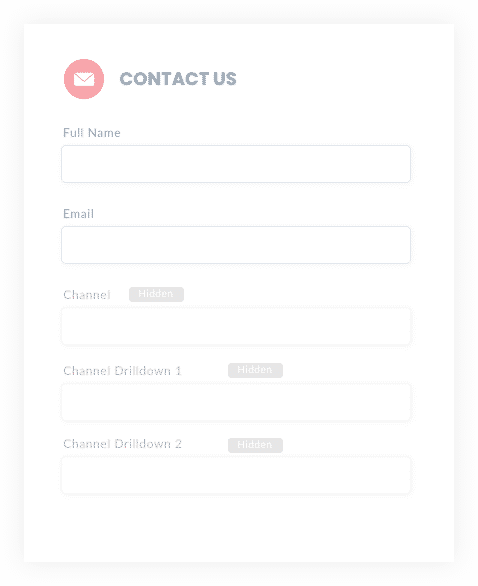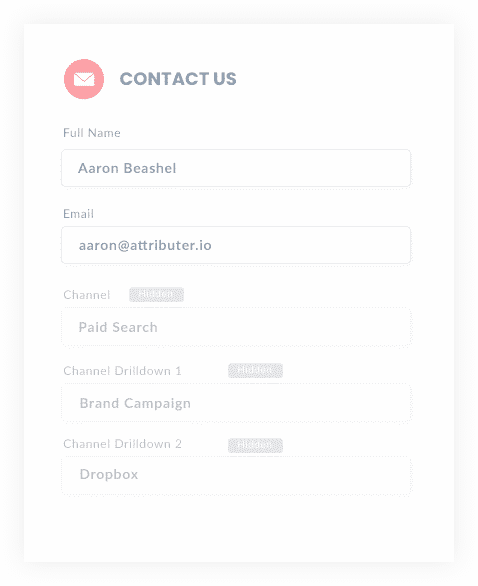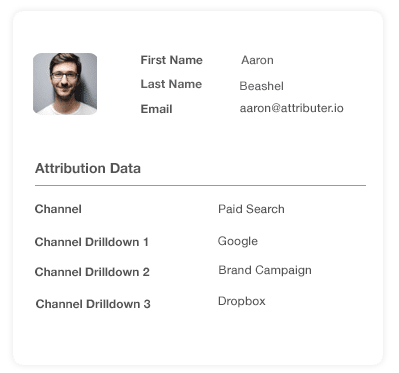4 simple steps to track UTM Parameters on Umbraco
Learn how to identify which marketing channels attract leads, opportunities and customers by tracking UTM parameters on your Umbraco site.
One of the secrets to growing a business is recognizing the content, campaigns and marketing channels that generate leads and customers at a positive ROI, and then pursuing those initiatives.
But if you can't tell exactly the given amount of leads, customers and revenue that is created by your marketing efforts, how can you say which is working and which isn't?
The secret to success is ensuring you're tracking the origin of every lead and opportunity in your CRM. That way, you can readily document which campaigns, content and channels are working.
This post shows you how to encapsulate UTM parameters on Umbraco and send them to your CRM and other tools so you can get the form of reporting that is necessary.
4 steps for capturing UTM parameters on Umbraco
Using Attributer to capture UTM parameters on Umbraco is easy. Here's how to do it in 4 easy steps:
1. Add UTM variables to your ads

Your first task is to track UTM parameters in your CRM and add them to your ads and campaigns. This allows Attributer to find out exactly where your website visitors are coming from, and in turn, relay them to your CRM for reporting on.
You should attach UTM parameters to any ads or campaigns you want to run. This could be on social media platforms like Twitter, Facebook, LinkedIn, and Instagram, or on search engines like Google and Bing.
It's even a good idea to attach them to bespoke campaigns as well. These include advertisements you may have in trade publications, email campaigns, etc.
2. Add hidden fields to your forms

The second step is to add hidden fields in the forms you use to collect information from site visitors(lead capture forms). These fields are not accessible to end-users but still exist on the form, so a tool like Attributer can interact with them and visitors would not be aware.
To add hidden fields to your Umbraco website is an easy task. In the form builder, drag and drop in the 'hidden field' field type or you can make an existing field hidden by selecting the 'Hidden' tickbox in the field's properties.
Here the hidden fields you need to add to your forms:
- Channel
- Channel Drilldown 1
- Channel Drilldown 2
- Channel Drilldown 3
- Landing Page
- Landing Page Group
3. Attributer automatically completes the hidden fields with UTM data

With all these in place, Attributer will obtain incoming tracking data, including UTM parameters, which it will attach to the hidden fields in your forms.
Let's take a quick look at how Attributer works using Dropbox as an example.
A user Goggles "ways to share large files" and finds a Dropbox ad in the paid results. The user clicks the ad and fills out a form to request a demo. In the form's hidden fields, Attributer will add the following tracking information (depending on what UTM parameters Dropbox uses):
- Channel = Paid Search
- Channel Drilldown 1 = Google
- Channel Drilldown 2 = Brand Campaign
- Channel Drilldown 3 = Dropbox
Also, the Attributer includes landing page information, which looks like this:
- Landing Page = www.dropbox.com/features/share
- Landing Page Group = Features
All this is dependent on the UTM parameters found on Dropbox.
4. UTM parameters are passed into your CRM

When the user submits your form, the UTM parameters written into the hidden fields are captured alongside the lead's name, email, phone, etc.
Using Umbraco native integrations, you can send this information to your CRM, email marketing tool, billing platform and more. You can also use tools like Zapier to send it to Google Sheets, Excel and hundreds of other destinations.
And once it's there, you can use it to run reports that show you things like:
- How many leads came from your Facebook Ads
- How many customers you got from your Google Ads
- How much revenue has been generated from your SEO efforts
- And much more
What is Attributer?
The steps above show how marketers optimize the features of Attributer to capture UTM parameters on their Umbraco site and relate them to their CRM and other tools.
But how does Attributer do this?
Attributer is a sequence of code you place on your website that surveys technical information about a visitor (UTM parameters, referrer, device, etc) to determine how visitors got to your site.
It then sorts each visitor into groups of channels such as organic search, paid search, paid social, etc. It then stores this data in a cookie in the visitor’s browser.
Then, when the user fills out a form on your website with those hidden fields, Attributer uses the data stored in the cookie to fill out the hidden fields.
Finally, when the user submits the form, the UTM parameters and other marketing attribution data are passed through to your CRM and other tools along with the lead's name, email, phone, etc.
Why using Attributer is better than capturing raw UTM parameters
There are other tools available for capturing UTM parameters on Umbraco sites however Attributer doesn't just capture raw UTM parameters and send them through to your CRM and other tools. Here's what else Attributer does:
1. Captures all traffic
Attributer captures ALL sources of traffic to your website and relays them to your CRM among other tools.
It is not just to the paid channels you've been able to add UTM parameters (like paid search and paid social), but it also includes channels where UTM parameters aren't present (like organic search, direct referral, organic social, etc.)
This means that as you run reports in your CRM to find out where your leads and customers are coming from, you'll also see the source of all your leads and not only those that came from your paid campaigns.
This will give you a better insight into what is working and what isn't and makes you grow your business better.
2. Remembers the data
Some other tools and methods for capturing UTM parameters require the UTM parameter to always be present on the page where the form is completed. This is a problem because the page they fill out your form may not be the same page they entered from your ad.
As an example, imagine a user clicks one of your Google Ads and goes to another page you created for that campaign.
Once they’re sure your product or service is amazing, they click the ‘Get A Quote’ button and are directed to a different page to complete your quote request form. This means that the page they fill a form is not the page they originally opened, so the UTM parameters are lost.
Attributer works by saving the UTM parameters in a cookie in the user’s browser so regardless of what page the user completes a form on, the UTM parameters will always be relayed through.
This means that someone could visit your site from Google Ads, browse through multiple pages, and when they eventually fill a form, the original UTM parameters will always be captured.
3. Provides cleaner data
One of the problems with using other tools that capture raw UTM parameters is that you can end up with messy data that makes it difficult to run accurate reports.
When you pass this data into your CRM and try to use it to see how many leads your Twitter campaigns have brought you, you'll get three different sources that you would then have to stitch together.
With Attributer, you don't have to deal with this though because it takes the possibility of capitalization and other inconsistencies into account, and will ascribe leads to the right channel regardless.
4. Captures landing page data as well
Ever wonder how many leads and customers come from your blog? Or those in-depth content pieces you spent hours writing?
Attributer not only captures UTM parameters and other channel data, but it also captures the landing page and the landing page category (i.e. /blog).
This means that you can see how well certain sections of your website are performing (I.e. your blog) in terms of generating leads, customers and revenue.
And because it captures both the landing page and the landing page group, you can look at how content groups as a whole are performing (I.e. your blog) as well as how individual pages or pieces of content are performing (I.e. individual blog posts).
Wrap up
As you can see, Attributer provides more than the basic UTM parameter capturing tool. Attributer does a lot of work behind the scenes to make sure you get better data for analysis.
It captures all incoming traffic data, ensures it isn't lost when visitors go from page to page and cleans it to make it easy to run reports.
Ready to experience the power of Attributer? Start a 14 day free trial to see if Attributer is right for you.
Get Started For Free
Start your 14-day free trial of Attributer today!

About the Author
Aaron Beashel is the founder of Attributer and has over 15 years of experience in marketing & analytics. He is a recognized expert in the subject and has written articles for leading websites such as Hubspot, Zapier, Search Engine Journal, Buffer, Unbounce & more. Learn more about Aaron here.
